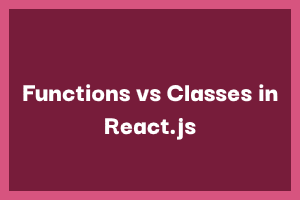Developers have two primary methods for constructing components using React.js, an effective JavaScript toolkit for developing user interfaces: functional components and class components. The precise requirements of the project will determine which strategy is best for you because each has its own advantages and disadvantages.
Functional Components:
React elements are returned by functional components, which are JavaScript methods that take props as arguments and render them on the screen. They primarily focus on producing user interfaces based on input data and are straightforward and stateless. With the introduction of Hooks in React 16.8, which gave them the ability to manage local component state and lifecycle methods, functional components gained popularity.
Advantages of Functional Components
Readability and simplicity: Functional elements are clear and simple to comprehend. Because they only use JavaScript functions, developers of all ability levels can use them.
Enhancing Performance: Because functional components tend to be lightweight, they can perform better. They are optimized for rendering and don’t have the overhead of class components.
Tests are simpler: Being pure functions, functional components are intrinsically simpler to test. output after input. They can therefore be used for unit testing without complicated setups.
The functional programming paradigm is encouraged: Functional components support the usage of pure functions and immutability in accordance with the principles of functional programming. Cleaner and more dependable code may result from this.
Class Components:
React components were initially made using class components. These classes extend React in JavaScript ES6.Component with access to local state, lifecycle methods, and other things. Class components are appropriate for complicated components that need lifecycle hooks or state management.
Advantages of Class Components
Local Component State: Class components can hold their own local state, which is managed using this.setState(). This is essential for components that need to manage and update their own data.
Lifecycle Approaches: Developers can hook into various stages of a component’s life cycle by using lifecycle methods like componentDidMount, componentDidUpdate, and componentWillUnmount available to class components.
Compatible with Legacy Code: Class components may still be used in older projects and libraries. Maintaining or contributing to such codebases requires a solid understanding of how to deal with them.
Refs for Child Component: When focusing on an input element, for example, class components’ ability to use refs to directly reference child components can be helpful.
The Right Choice:
The specific project needs should be taken into consideration while choosing between functional and class components. Functional components are frequently the best option for stateless, stateless UI components because of their simplicity and performance advantages. Class components, on the other hand, can be better suited for complicated components that need local state management or that must hook into the component lifecycle.
The English language is the most widely used language as a medium of communication around the world. Having a certification for the English language can be an advantage. StudySection provides an English Certification Exam that tests English language proficiency in English grammar, reading, and writing.




